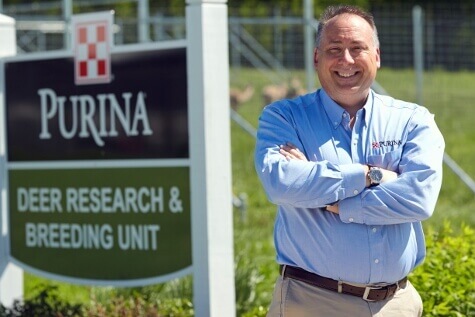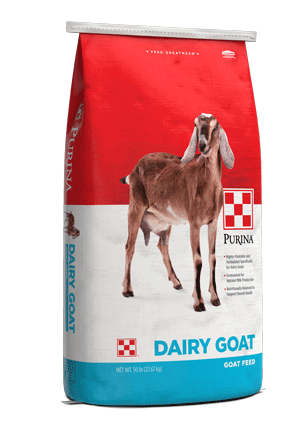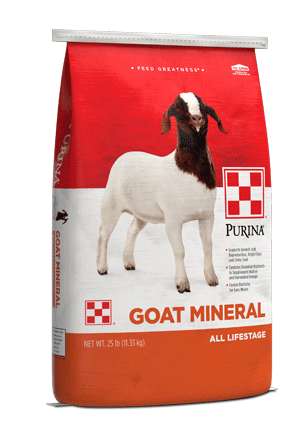
Dairy Goat Gestation Feeding Tips
Wellness : Nutrition
The gestation period of dairy goats is broken down into two distinct periods – early-to-mid gestation and late gestation. Each stage has different nutrient requirements to help maintain goat health and meet energy needs.
Meeting the nutritional needs of the dry doe during each stage of gestation will help prevent metabolic problems, aid in the delivery of healthy kids and support milk production.
The fetus has the most growth in utero during late gestation (the last 50 days). Energy and nutrient needs increase significantly compared to maintenance or early-to-mid goat gestation. Energy requirements increase 28%, with a 42% increase in protein requirements compared to early lactation for a 154 lb. (70 kg) doe carrying twins.1 Goat nutrition requirements will increase further when there are additional kids.
Some producers feed different diets for late gestation and lactation. Two weeks before kidding is an excellent time to start the goat diet transition. Start transitioning from a lower protein and calcium forage (grasses such as bermudagrass, orchardgrass, timothy) to a higher protein and calcium forage (like legumes such as alfalfa and clover).
It’s also beneficial to feed a forage lower in protein and calcium, like grass hay, during the dry period to help decrease the chance of milk fever in goats during lactation. A lower calcium dairy goat diet during the dry period will help a doe mobilize the calcium in her body when it’s needed during early lactation.
Late gestation is a good time to consult with your herd veterinarian to discuss your goat health program and make sure kids get off to a healthy start.
Get more tips for keeping goats healthy during gestation.
1 [NRC] National Research Council. 2007. Nutrient Requirements of Small Ruminants. National Academy Press. Washington, DC.
Meeting the nutritional needs of the dry doe during each stage of gestation will help prevent metabolic problems, aid in the delivery of healthy kids and support milk production.
Energy changes during goat gestation
The average gestation period of dairy goats is 150 days. There’s little fetal development during early-to-mid gestation (the first 100 days), meaning goat nutrition and energy requirements are only slightly higher than the requirements during maintenance and breeding.The fetus has the most growth in utero during late gestation (the last 50 days). Energy and nutrient needs increase significantly compared to maintenance or early-to-mid goat gestation. Energy requirements increase 28%, with a 42% increase in protein requirements compared to early lactation for a 154 lb. (70 kg) doe carrying twins.1 Goat nutrition requirements will increase further when there are additional kids.
Late gestation goat nutrition requirements
Increase the energy and nutrient density of the goat diet during late gestation (the last 50 days) by gradually adding a concentrate feed to the diet over 7-10 days. Then, start increasing the energy and nutrient content of the goat diet even further during the last 30 days before kidding. Increase the total amount of concentrate diet fed weekly to achieve the amount required for lactation by kidding time.Some producers feed different diets for late gestation and lactation. Two weeks before kidding is an excellent time to start the goat diet transition. Start transitioning from a lower protein and calcium forage (grasses such as bermudagrass, orchardgrass, timothy) to a higher protein and calcium forage (like legumes such as alfalfa and clover).
Support goat health
Provide sufficient nutrition during late goat gestation to help maintain or improve body condition. Pregnancy toxemia in goats is a greater risk when does are too thin or too heavy. Aim for a body condition score of 3 out of 5 going into lactation.2It’s also beneficial to feed a forage lower in protein and calcium, like grass hay, during the dry period to help decrease the chance of milk fever in goats during lactation. A lower calcium dairy goat diet during the dry period will help a doe mobilize the calcium in her body when it’s needed during early lactation.
Late gestation is a good time to consult with your herd veterinarian to discuss your goat health program and make sure kids get off to a healthy start.
Get more tips for keeping goats healthy during gestation.
1 [NRC] National Research Council. 2007. Nutrient Requirements of Small Ruminants. National Academy Press. Washington, DC.
2 Carlson, J. 2017. Dairy goat body condition scoring. American Dairy Goat Association and University of California-Davis. Available at: https://adga.org/wp-content/uploads/2017/11/adga-dairy-goat-body-condition-scoring.pdf.



.png?width=300&height=430&ext=.png)
